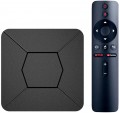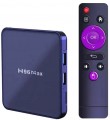Operating system
—
Proprietary system. The operating system of the device is represented by the proprietary software shell of the manufacturer. Usually, such operating systems have an attractive and convenient menu. A proprietary operating system is developed directly by the manufacturer for the hardware resources of a particular model or a whole line, but has limited capabilities.
—
Android (AOSP). This type of operating system is a modification of the popular Android OS, mainly notable for being open source. It is a versatile operating system that gives the user much more freedom to create changes and customizations within the system itself. At the same time, the installation and stability of certain applications on this platform are not guaranteed, and the overall system management was not specially “tailored” for large screens, which may cause some inconvenience. First of all, such solutions will interest users who understand the features of the Android OS, like to customize and control everything for themselves, and have time for this.
—
Android TV. Devices of this type have full-fledged Android TV software, specially adapted to work on large screens. In accordance with the name, it is a type of Android OS, specially designed for such equipment. In addition to the common features of all Androids (such as the ability to install additional applications, including
...even games), it has a number of special features: an optimized interface, integration with smartphones (including the ability to use them as a remote control), voice search, etc. Thanks to this, TVs with this feature are significantly superior in functionality to models with a “regular” Smart TV. Of course, a dedicated processor, graphics subsystem and memory are provided for the operation of a multifunctional OS, and the presence of such hardware resources is reflected in the overall cost.
— Google TV. Rebranding of the Android TV platform for TVs and smart consoles, or rather, a new shell on top of the operating system under the sign of the “green droid”, introduced since 2021. Among the innovations, it has a redesigned user interface, an improved knowledge base that more efficiently distributes content by genre and collects search information from the entire list of installed applications and subscriptions. The voice assistant now understands the needs of the audience better and provides a detailed list of what was found. A separate tab in the interface contains live broadcasts of current events, whether it be sports events or a rocket launch to Mars. Among other things, the aspects that involve the use of TV as a command post for managing a single ecosystem of a “smart” home have been improved in the system.Bluetooth
Bluetooth is a technology used to connect various devices wirelessly directly. In media centers and TV receivers, it can be used to broadcast sound to wireless headphones and acoustics, to work with wireless mice and keyboards, to use a smartphone / tablet as a remote control, etc.; specific functionality should be specified separately. Also note that the supported version of Bluetooth can be specified here. The newest and most advanced is
Bluetooth 5.0, but here is a more detailed description of the different versions:
- Bluetooth v4.0. The version in which the "Bluetooth Low Energy" (LE) format was first introduced — in addition to regular Bluetooth (version 2.1 functionality) and the high-speed HE standard for transferring large amounts of information (introduced in version 3.0). Bluetooth LE allows you to significantly reduce power consumption when transmitting small data packets, such as request-responses about connection activity in idle mode. For the media centers and TV receivers themselves, this is not particularly important, but for portable equipment (especially miniature ones, where battery capacity is very limited), such functionality will be useful.
- Bluetooth v 4.1. Development and improvement of Bluetooth 4.0. One of the key improvements was the optimization of collaboration with 4G LTE communication modules so that Bluetooth and LTE do not interfere with each other. In addition, this ve...rsion has the ability to simultaneously use a Bluetooth device in several roles — for example, to remotely control an external device while simultaneously streaming music to headphones.
- Bluetooth v4.2. Further, after 4.1, the development of the Bluetooth standard. It did not introduce fundamental updates, but received a number of improvements regarding reliability and noise immunity, as well as improved compatibility with the Internet of Things.
- Bluetooth v5.0. Version introduced in 2016. One of the most notable updates was the introduction of two new modes of operation for Bluetooth LE — with an increase in speed by reducing the range and with an increase in range by reducing the speed. In addition, a number of improvements have been introduced regarding simultaneous work with numerous connected devices, as well as work with the components of the Internet of Things.
AirPlay
The technology of broadcasting audio and video signals through a Wi-Fi connection. Widely used in Apple electronics, the media centre with AirPlay will make it easy to duplicate a “picture” on a TV, for example, from an iPhone or iPad. The main disadvantage of this technology compared to similar Miracast is the need for a local network with a wireless router.
Miracast
A wireless technology that allows you to directly broadcast video and audio from one device to another directly over a Wi-Fi connection. At the same time, unlike AirPlay, transmission does not require a router and building a local network — it is enough that the receiver and transmitter are compatible with Miracast. One of the most popular ways to use this technology is to output a “picture” from a smartphone / tablet screen to a TV, and vice versa.
A media centre or TV receiver with Miracast is useful if the TV itself does not support this function.
Card reader
A device for reading memory cards, most often in SD format. This feature is especially useful for exchanging information with some types of modern electronics: almost all cameras and laptops are equipped with card readers, and microSD cards used in smartphones and other pocket gadgets can be used in SD slots using simple adapters. Thanks to the
card reader, you can, for example, easily view materials captured on a camera or smartphone camera, copy music and movies from a laptop to a media centre, and even perform some special tasks, such as updating the player's firmware. In video capture devices, the built-in card reader allows user to add the drive to the list of computer disks.
CPU
The model of the CPU installed in the media player.
This information is mainly of reference value: the processor is selected in such a way as to provide certain practical characteristics (maximum resolution, support for certain standards, embedded applications, etc.). So when choosing, you should focus primarily on these specifications. However, if you wish, knowing the processor model, you can find detailed data on it and evaluate the capabilities of the media centre to work with resource-consuming applications. This can be useful, in particular, if you choose an Android model (see above) and plan to use additional software intensively — the set of applications for this OS is very extensive, and some of them are quite demanding on system resources.
Also note that CPU data is often specified for advertising purposes — to emphasize that the device has a fairly advanced chip from a well-known brand. Among the most common brands of such processors are
Allwinner,
Amlogic,
Rockchip,
Realtek.
CPU frequency
The clock speed of the CPU installed in the media centre.
On the technical side, the higher this indicator, the faster the processor works and the higher, accordingly, the overall system performance. At the same time, the CPU performance depends, in addition to the frequency itself, on a number of factors — architecture, number of cores, special design features, etc.; and the actual speed of the entire system is affected by performance of components other than the processor. In addition, manufacturers usually select processors in such a way that their computing power is guaranteed to be enough for all the features claimed for a media centre. Therefore, in this case, the CPU frequency is more of a reference parameter (and partly an advertising indicator that demonstrates the advanced specifications of the device), rather than practically significant for buyer.
Built-in memory
The volume of
its own storage installed in the media player.
In this case, storage means permanent memory available to the user — the storage that you can fill with movies, music, applications, etc. The larger the volume of such storage, the more convenient it is for the user; on the other hand, this parameter significantly affects the cost of the entire device. In addition, it should noted that external media are also quite suitable for films and other multimedia content — flash drives, portable HDDs, drives installed in a slot (see below), optical discs, etc. So specifically look for a model with a capacious storage makes sense in two main cases. The first is if you want to keep an extensive collection of content in the media player, so as not to bother once again with connecting flash drives, loading disks, etc. it is best to put it in the built-in memory, and often this is the only possible option).
As for specific volumes, the capacity
up to 4 GB is considered very limited nowadays; such a storage is not enough even for a movie in HD 720p, its purpose is mainly to store a small set of applications.
8 GB and
16 GB are also relatively small, but this already allows you to work with a fairly extensive set of software and store individual movies in HD resolutions. And if you initially intend to store a large amount of c
...ontent on the device, you should definitely pay attention to models with a capacity of 32 GB or more.Video decoders
Codec — from the phrase "Encoder-DECoder" — in this case is the format used for encoding digital video during storage/transmission and decoding during playback (without encoding, video data would take up an unjustifiably large amount of space). Do not confuse this parameter with the format of video files: different files of the same format can be encoded with different codecs, and if the corresponding codec is not supported by the player, video playback will be impossible, even if the file format itself corresponds to the capabilities of the device. And in models with online TV support (see "Features") this nuance also determines compatibility with a specific broadcast: the general format of the broadcast is indicated by the codec used for this.
In general, modern devices usually have quite extensive sets of codecs (one of the most advanced is
H.265,
AV1 codecis also popular), and there are usually no problems with video playback; in extreme cases, you can use special programs for transcoding files. As for specific codecs, detailed data on them can be found in special sources, but with standard use of media players, such details are not needed.

